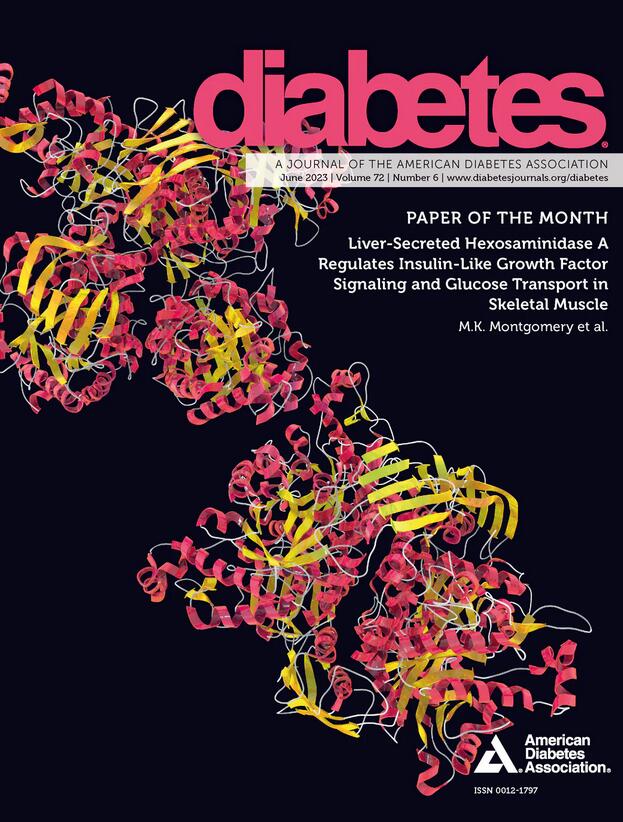ALY688通过激活ER吞噬减轻铁诱导的内质网应激和胰岛素抵抗
IF 7.5
1区 医学
Q1 ENDOCRINOLOGY & METABOLISM
引用次数: 0
摘要
铁超载(IO)是代谢综合征(MetS)的一个共同因素,包括胰岛素抵抗。io诱导的胰岛素抵抗机制包括氧化应激升高、内质网应激和自噬受损。利用Akt生物传感器L6骨骼肌细胞系,研究人员发现脂联素受体激动剂ALY688可防止IO引起的胰岛素信号通路受损。在机制上,ALY688抵消了io依赖性对内质网应激、未折叠蛋白反应(UPR)和自噬通量的影响。重要的是,我们发现ALY688诱导fam134b依赖性ER吞噬(网状吞噬)来改善ER应激。在缺乏Atg7或FAM134B的细胞中,ALY688的有益作用减弱,这突出了FAM134B选择性自噬内质膜在减轻io诱导的胰岛素信号通路受损中的重要性。这些发现转化为小鼠IO模型,ALY688改善葡萄糖耐量,胰岛素敏感性,UPR激活,FAM134B表达和自噬通量。总之,我们的研究结果表明,ALY688通过刺激UPR和ER吞噬,有效地减轻了小鼠和细胞骨骼肌模型中io诱导的内质网应激和胰岛素抵抗。本研究为过量铁和胰岛素抵抗之间的关系增加了机制见解,并确定了有效的干预策略。通过细胞骨骼肌细胞模型和临床前动物模型,我们发现铁引起内质网应激并损害胰岛素信号传导。脂联素受体激动剂肽ALY688抵消铁诱导的内质网应激并维持胰岛素敏感性。功能丧失方法表明,ALY688通过自噬依赖,特别是er -吞噬依赖的机制起作用。本文章由计算机程序翻译,如有差异,请以英文原文为准。
ALY688 Attenuates Iron-Induced ER Stress and Insulin Resistance via Activation of ER-Phagy
Iron overload (IO) is a common contributing factor to aspects of the metabolic syndrome (MetS), including insulin resistance. Mechanisms of IO-induced insulin resistance include elevated oxidative stress, endoplasmic reticulum (ER) stress and impaired autophagy. Using an Akt biosensor L6 skeletal muscle cell line, we found that the adiponectin receptor agonist ALY688 prevented impaired insulin signaling in response to IO. Mechanistically, ALY688 counteracted IO-dependent effects on ER stress, the unfolded protein response (UPR), and autophagic flux. Importantly, we found that ALY688 induced FAM134B-dependent ER-phagy (reticulophagy) to ameliorate ER stress. The beneficial effects of ALY688 were attenuated in cells lacking Atg7 or FAM134B, highlighting the importance of selective autophagy of the ER by FAM134B in mitigating IO-induced impaired insulin signaling. These findings translated to a mouse model of IO in which ALY688 improved glucose tolerance, insulin sensitivity, UPR activation, FAM134B expression, and autophagy flux. Collectively, our results demonstrate that ALY688 effectively attenuated IO-induced ER stress and insulin resistance in both mice and cellular skeletal muscle models via stimulation of the UPR and ER-phagy. Article Highlights This study adds mechanistic insight to the association between excess iron and insulin resistance and identifies an effective intervention strategy. Using a cellular skeletal muscle cell model and a preclinical animal model, we show that iron elicits endoplasmic reticulum (ER) stress and impairs insulin signaling. The adiponectin receptor agonist peptide ALY688 counteracts iron-induced ER stress and maintains insulin sensitivity. Loss-of-function approaches indicated that ALY688 acts via an autophagy-dependent, and specifically ER-phagy–dependent, mechanism.
求助全文
通过发布文献求助,成功后即可免费获取论文全文。
去求助
来源期刊

Diabetes
医学-内分泌学与代谢
CiteScore
12.50
自引率
2.60%
发文量
1968
审稿时长
1 months
期刊介绍:
Diabetes is a scientific journal that publishes original research exploring the physiological and pathophysiological aspects of diabetes mellitus. We encourage submissions of manuscripts pertaining to laboratory, animal, or human research, covering a wide range of topics. Our primary focus is on investigative reports investigating various aspects such as the development and progression of diabetes, along with its associated complications. We also welcome studies delving into normal and pathological pancreatic islet function and intermediary metabolism, as well as exploring the mechanisms of drug and hormone action from a pharmacological perspective. Additionally, we encourage submissions that delve into the biochemical and molecular aspects of both normal and abnormal biological processes.
However, it is important to note that we do not publish studies relating to diabetes education or the application of accepted therapeutic and diagnostic approaches to patients with diabetes mellitus. Our aim is to provide a platform for research that contributes to advancing our understanding of the underlying mechanisms and processes of diabetes.
 求助内容:
求助内容: 应助结果提醒方式:
应助结果提醒方式:


